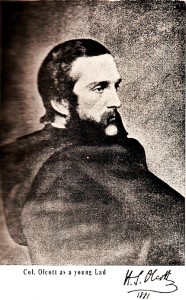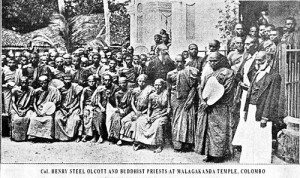Colonel Henry Steele Olcott’s memorable visit to Ceylon in 1880
Colonel Henry Steele Olcott whose 108th death anniversary falls on February 17, described his travels and work in Sri Lanka (then Ceylon) as follows:-
“Ah, lovely Lanka, gem of the Southern seas, how doth thy sweet image rise before me as I write the story of my experiences among thy dusky children, of my success in warming their hearts to reverse their incomparable religion and its holy Founder.”
It was in 1880 that a visit of Col. Olcott’s party to Sri Lanka (then Ceylon), long requested by the leading priests and laity of the Buddhist community, had been determined upon, and the preparations occupied them throughout the month. Everything being ready, they embarked on May 7, in a British India steamer for Sri Lanka (then Ceylon).

Col. Olcott as a young man
The party consisted of the two founders of the Theosophical Society, Mme Blavatsky and Col. Olcott, Mr. Wimbridge, Damodar K. Mavalankar, Purshotam and Panachand Anandji (Hindus), Sorabj, J. Padshah and Ferozshah D. Shroft (Parsis). The wife of Mr. Purshotam, a delicate, fragile little lady, accompanied her husband.
Writing in his diary on the day before reaching Colombo, Col. Olcott said, “New and great responsibilities are to be faced, momentous issues hang on the result of this visit.” Nothing could have been truer than that. They dropped anchor in Colombo harbour on the morning of May 16, 1880 and after a while a large boat came alongside bringing Ven. Mohottiwatte Gunananda, the Buddhist orator priest, and some junior priests of Ven. Migettuwatte’s Pansala. They found the famed Ven. Migettuwatte, a middle-aged shaven monk, of full medium stature, with a very intellectual head, a bright eye, very large mouth, and an air of perfect self – confidence and alertness. Some of the more meditative monks habitually drop their eyes when conversing with one, but he (Ven. Migettuwatte) looked them square in the face, as befitted the most brilliant polemic orator of the Island, the terror of the Missionaries.
Arrival at Galle
Before dawn on May 17, 1880 they were off the Galle light house and getting their pilot, anchored about 500 yards from shore. The monsoon burst, and there was tremendous wind and rain, but the view was so lovely that they stopped on deck to enjoy it. A beautiful bay, a verdant promontory to the north, against which the surf dashed and in foamy jets ran high up against the rocky shore, a long curved sandy beach bordered with file – roofed bungalows almost hidden in an ocean of green palms, the old fort, custom house, light house, jetty and coaling sheds to the south, and to the east, the tossing sea with a line of rocks and reefs walling it out from the harbour. Far away inland rose Adam’s Peak and sister mountains.
After breakfast, they embarked in a large boat decorated with plantain trees and lines of bright -coloured flowers, on which were the leading Buddhists of the place. They passed through a line of fishing boats decorated with cloths and streamers, their prows pointing inward. On the jetty and along the beach a huge crowd awaited them and rent the air with the united shout of “Sadhoo! Sadhoo!.
A white cloth was spread for them from the jetty steps to the road where carriages were ready, and a thousand flags frantically waved in welcome. The multitude hemmed in their carriages, and procession set out for their appointed residence, the house of Mrs. Wijeratne, the wealthy window of a late P & O contractor. The roads were blocked with people the whole distance, and their progress was very slow.
At the house three Chief Priests received and blessed them at the threshold reciting appropriate Pali verses. The people were crowding every approach, filling every door and gazing through every window. Their hostess and her son, the Deputy Coroner of Galle, lavished hospitality upon them, loading the table with delicacies and delicious fruits, such as they had never seen and dressing it in the charming Sinhalese manner, with flowers and pretty leaves. Every now and then a new procession of yellow-robed monks, arranged in order of seniority of ordination and each carrying their palm-leaf fan, came to visit and bless them. It was an intoxicating experience altogether, a splendid augury of their future relations with the nation.
Wimbridge and Col. Olcott went for a dip in the harbour very early the next morning, but they were followed and watched by crowds, so that it was very uncomfortable to move about. Their rooms were packed with visitors all day. There were no end of metaphysical discussions with the aged High Priest Ven. Bulathgama Sumanatissa and other sharp logicians and he begged him to call on a list of Europeans and to write to twenty Burghers inviting them to join with the Buddhists in forming a Branch Theosophical Society.
In his innocence he did so, and the next morning could have bitten off his finger for shame, for they sent him insulting replies, saying that they were Christians and wanted to have nothing to do with Theosophy or Buddhism.
First public lecture
As it had been arranged that Col. Olcott should give a public lecture on Theosophy on May 22, 1880, he made desperate efforts to think over his subject and prepare some notes. It was delivered in a large room in the Military Barracks, imperfectly lighted, and packed to suffocation. A temporary platform had been erected at one end and a figure canopy suspended over it. Besides their delegation there were upon it Sumangala Maha Thero, the Chief Priest Ven. Bulathgama, Chief Priest Ven. Dhammalankara, of the Amarapoora Sector, who had come 28 miles to meet them, and a number more. Forty five Europeans were present, and inside and outside, some 2000 Sinhalese. At that time the light was so bad that he could not read his notes. However, he managed to get through somehow.
Recited Pansil
On May 25, 1880, Col. Olcott took pan sil from the Venerable Bulathgama, at a temple of the Ramanya Nikaya. A great arch of greenery, bearing the words, “Welcome to the members of the Theosophical Society.” had been created within the compound of the vihara. He had trouble in catching the Pali words that he was to repeat after the old monk. A great crowd was present and made the responses just after them, a dead silence being preserved while they were struggling through the unfamiliar sentences.
From Galle to Kalutara

Col. Olcott with Buddhist monks at Maligakanda temple
From Galle to Kalutara, crowds had gathered to look at them, and they were invited to stop and refresh themselves with king coconuts, milk, tea and cakes. At several points, so large was the concourse, he had to get out of the carriage and address the crowd. At Dodanduwa they were greeted with such a downpour of monsoon rain as had not been seen in years. Next morning, in the two stage-coaches supplied by their friends, he had to make four speeches on that day. The first from the steps of the coach before starting, the second from the steps of the bungalow at Ambalangoda, the third at Piyagala, where they breakfasted and the fourth at the temple at Piyagala, when an audience of 3000 to 4000 had gathered. They were taken in a heavy rain, in procession, with banners and tomtoms working the crowd up into a sort of frenzy of jubilation.
From Kalutara to Colombo
At that time the railway ended at Kalutara, and they took the train for their next station, Panadura, the locality where Ven. Migettuwatte debated against the Missionaries the respective merits of Buddhism and Christianity. They were lodged in a new pansala adjoining a vihara, which had just been erected by a picturesque looking old man, named Andris Perera, at his own cost. “Mr. Andris was tall, thin, dark, had a spacious forehead, wore his hair brushed back and twisted into a long switch, which was put up like a woman’s hair, with an immense and costly tortoise – shell comb, a Sinhalese fashion, arched over his head. Mr. Andris wore the country dhoti and a single breasted, last century coat of blue cloth, with long skirts, turnover cuffs, 20 large gold buttons down one side of the front and as many loops and lacings of gold lace. His feet were bare and he wore leather sandals.” The figure was so striking, so unlike any other they saw, that he (Col. Olcott) noted the details in his Diary.
At 2 p.m. he addressed another huge audience on the very spot where the famous “Panadura debate” had been held. After him Ferozshah (Parsi) and Pranchand (Hindu) made some remarks as representatives in their Society of their respective races. Ven. Migettuwatte Thera presided and made eloquent speeches.
On June 5, Col. Olcott lectured at Ven. Migettuwatte’s Thera’s own temple at Kotahena, the one which was visited by most of the steamer passengers touching at the port. Ven. Megittuwatte Thera and he spoke standing on a large table placed in the middle of the hall. The hall and compound were packed with people and the heat was most oppressive. The place was gaily decorated with flags and coloured cloths.
A visit to Kelaniya temple, one of the most revered shrines in the Island, where the great stupa rests over genuine relics of the Buddha himself, and the inevitable lecture and multitudinous audience followed. On the next day, June 8, they organised the Colombo Theosophical Society with 27 members.
From Colombo to Kandy
They left for Kandy by train on June 9, and after the run of four and a half hours through one of the most picturesque tracks of country arrived at about 7 p.m. The next morning they received ceremonial visits from the Chief Priests of Asgiriya and Malwatte Temples. They went to the temple at 2 p.m. for his (Col. Olcott) lecture, but such a crowd had wedged itself inside that it was only with the greatest difficulty that he could reach his table. A lecture at the town hall on “The Life of Buddha and its Lessons” had been arranged for the next evening. He worked desperately to get it written under the most discouraging disadvantages. However, he managed and gave the lecture in due course to a packed crowd. Most of the influential Government officials were present, and the applause was constant enough to make them think it a success.
At 9 a.m. the next morning, the unusual honour was conferred upon them of admitting them to a special exposition of the Buddha’s Tooth Relic. He believed that the relic had not been previously exposed since the visit of the Prince of Wales, so that this was regarded as the highest honour that could possibly have been shown them.
Ananda College has organized a ceremony to mark Col. Henry Steele Olcott Day, on February 16 ( instead of Feb. 17) at the Kularatne Hall from 9 a.m. onwards.


